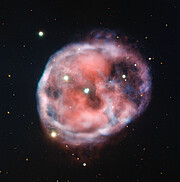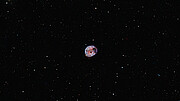Tisková zpráva
Hvězdy a lebky: nový snímek ESO odhaluje strašidelnou mlhovinu
30. října 2020
Tento éterický pozůstatek dávno mrtvé hvězdy, který na obloze naleznete na břiše souhvězdí Velryby, nápadně připomíná lebku plující vesmírem. Strašidelná planetární mlhovina s přiléhavým jménem „Lebka“ je na tomto novém záběru zachycena v působivých barvách a neobyčejných detailech prostřednictvím dalekohledu ESO/VLT. Jedná o první objekt tohoto typu, u něhož je známo, že souvisí s párem těsně vázaných hvězd, kolem kterého obíhá třetí stálice.
Mlhovina Lebka, která je také známa pod katalogovým označením NGC 246, leží asi 1 600 světelných let od nás a na obloze se nachází v souhvězdí Velryby (Cetus). Vznikla v závěrečné fázi vývoje hvězdy podobné Slunci, když umírající stálice odvrhla své vnější plynné obálky a zanechala po sobě jen obnažené jádro – takzvaného bílého trpaslíka (white dwarf), kterého můžete spatřit jako jeden z dvojice bodových zdrojů v samotném středu mlhoviny.
I když je tato mlhovina známa po celá staletí, až v roce 2014 díky dalekohledu ESO/VLT astronomové zjistili, že bílý trpaslík a jeho souputník v srdci mlhoviny Lebka ukrývají ještě třetí hvězdu – slabého červeného trpaslíka (red dwarf, na snímku není patrný). Červený a bílý trpaslík obíhají kolem sebe jako pár ve vzdálenosti asi jen 500krát větší, než dělí Zemi a Slunce. Třetí hvězda obíhá tuto dvojici zhruba 1 900krát dále, než Země kolem Slunce. Společně tato trojice hvězd učinila z NGC 246 první známou planetární mlhovinu, která má ve svém středu hierarchický trojhvězdný systém.
Snímek mlhoviny Lebka, který byl pořízen pomocí přístroje FORS 2 a dalekohledu ESO/VLT na Observatoři Paranal v Chilské poušti Atacama, záměrně zachycuje pouze světlo emitované v určitých úzkých pásmech vlnových délek atomy vodíku a kyslíku. Pozorování záření produkovaného konkrétními prvky pomáhá odhalit mnoho informací o chemickém složení a struktuře objektu. Na tomto záběru jsou červeně zvýrazněny oblasti, kde vyzařuje vodík, a světle modrou kyslík.
Uvedený obrázek byl pořízen v rámci programu ESO Cosmic Gems. Jedná se o iniciativu, jejímž úkolem je získávat astronomické snímky vizuálně atraktivních objektů pro vzdělávací a popularizační účely. Program využívá krátkých úseků jinak nevyužitého pozorovacího času dalekohledů, aby dopad na vědecká pozorování byl minimální. Získaná data jsou však k dispozici také odborníkům prostřednictvím vědeckých archivů ESO.
Další informace
ESO je nejvýznamnější mezivládní astronomická organizace v Evropě, která v současnosti provozuje nejproduktivnější pozemní astronomické observatoře světa. ESO má 16 členských států – Belgie, Česko, Dánsko, Finsko, Francie, Irsko, Itálie, Německo, Nizozemsko, Portugalsko, Rakousko, Španělsko, Švédsko, Švýcarsko, Velká Británie – a dvojici strategických partnerů – Chile, která hostí všechny observatoře ESO, a Austrálii. ESO uskutečňuje ambiciózní program zaměřený na návrh, konstrukci a provoz výkonných pozemních pozorovacích komplexů umožňujících astronomům dosáhnout významných vědeckých objevů. ESO také hraje vedoucí úlohu při podpoře a organizaci celosvětové spolupráce v astronomickém výzkumu. ESO provozuje tři unikátní pozorovací střediska světového významu nacházející se v Chile: La Silla, Paranal a Chajnantor. Na Observatoři Paranal pracují dalekohledy systému VLT (Velmi velký dalekohled) schopné fungovat společně jako interferometr VLTI a dva přehlídkové teleskopy – VISTA pro infračervenou a VST pro viditelnou oblast spektra. Na Observatoři Paranal bude umístěn a provozován také největší a nejcitlivější teleskop pro sledování záření gama – Cherenkov Telescope Array South. ESO je také významným partnerem zařízení umístěných na planině Chajnantor – APEX a ALMA, největšího astronomického projektu současnosti. Nedaleko Observatoře Paranal, na hoře Cerro Armazones, staví ESO nový dalekohled ELT (Extrémně velký dalekohled) s primárním zrcadlem o průměru 39 m, který se stane „největším okem lidstva hledícím do vesmíru“.
Odkazy
Kontakty
Bárbara Ferreira
ESO Public Information Officer
Garching bei München, Germany
Tel.: +49 89 3200 6670
Mobil: +49 151 241 664 00
Email: pio@eso.org
Anežka Srbljanović (press contact Česko)
ESO Science Outreach Network
a Astronomical Institute of Czech Academy of Sciences
Tel.: +420 323 620 116
Email: eson-czech@eso.org
O zprávě
| Tiskové zpráva č.: | eso2019cs |
| Jméno: | NGC246 |
| Typ: | Milky Way : Star : Evolutionary Stage : White Dwarf Milky Way : Nebula : Type : Planetary |
| Facility: | Very Large Telescope |
| Instruments: | FORS2 |
Our use of Cookies
We use cookies that are essential for accessing our websites and using our services. We also use cookies to analyse, measure and improve our websites’ performance, to enable content sharing via social media and to display media content hosted on third-party platforms.
ESO Cookies Policy
The European Organisation for Astronomical Research in the Southern Hemisphere (ESO) is the pre-eminent intergovernmental science and technology organisation in astronomy. It carries out an ambitious programme focused on the design, construction and operation of powerful ground-based observing facilities for astronomy.
This Cookies Policy is intended to provide clarity by outlining the cookies used on the ESO public websites, their functions, the options you have for controlling them, and the ways you can contact us for additional details.
What are cookies?
Cookies are small pieces of data stored on your device by websites you visit. They serve various purposes, such as remembering login credentials and preferences and enhance your browsing experience.
Categories of cookies we use
Essential cookies (always active): These cookies are strictly necessary for the proper functioning of our website. Without these cookies, the website cannot operate correctly, and certain services, such as logging in or accessing secure areas, may not be available; because they are essential for the website’s operation, they cannot be disabled.
Functional Cookies: These cookies enhance your browsing experience by enabling additional features and personalization, such as remembering your preferences and settings. While not strictly necessary for the website to function, they improve usability and convenience; these cookies are only placed if you provide your consent.
Analytics cookies: These cookies collect information about how visitors interact with our website, such as which pages are visited most often and how users navigate the site. This data helps us improve website performance, optimize content, and enhance the user experience; these cookies are only placed if you provide your consent. We use the following analytics cookies.
Matomo Cookies:
This website uses Matomo (formerly Piwik), an open source software which enables the statistical analysis of website visits. Matomo uses cookies (text files) which are saved on your computer and which allow us to analyze how you use our website. The website user information generated by the cookies will only be saved on the servers of our IT Department. We use this information to analyze www.eso.org visits and to prepare reports on website activities. These data will not be disclosed to third parties.
On behalf of ESO, Matomo will use this information for the purpose of evaluating your use of the website, compiling reports on website activity and providing other services relating to website activity and internet usage.
Matomo cookies settings:
Additional Third-party cookies on ESO websites: some of our pages display content from external providers, e.g. YouTube.
Such third-party services are outside of ESO control and may, at any time, change their terms of service, use of cookies, etc.
YouTube: Some videos on the ESO website are embedded from ESO’s official YouTube channel. We have enabled YouTube’s privacy-enhanced mode, meaning that no cookies are set unless the user actively clicks on the video to play it. Additionally, in this mode, YouTube does not store any personally identifiable cookie data for embedded video playbacks. For more details, please refer to YouTube’s embedding videos information page.
Cookies can also be classified based on the following elements.
Regarding the domain, there are:
- First-party cookies, set by the website you are currently visiting. They are stored by the same domain that you are browsing and are used to enhance your experience on that site;
- Third-party cookies, set by a domain other than the one you are currently visiting.
As for their duration, cookies can be:
- Browser-session cookies, which are deleted when the user closes the browser;
- Stored cookies, which stay on the user's device for a predetermined period of time.
How to manage cookies
Cookie settings: You can modify your cookie choices for the ESO webpages at any time by clicking on the link Cookie settings at the bottom of any page.
In your browser: If you wish to delete cookies or instruct your browser to delete or block cookies by default, please visit the help pages of your browser:
Please be aware that if you delete or decline cookies, certain functionalities of our website may be not be available and your browsing experience may be affected.
You can set most browsers to prevent any cookies being placed on your device, but you may then have to manually adjust some preferences every time you visit a site/page. And some services and functionalities may not work properly at all (e.g. profile logging-in, shop check out).
Updates to the ESO Cookies Policy
The ESO Cookies Policy may be subject to future updates, which will be made available on this page.
Additional information
For any queries related to cookies, please contact: pdprATesoDOTorg.
As ESO public webpages are managed by our Department of Communication, your questions will be dealt with the support of the said Department.





